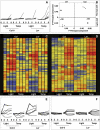Potent induction of Arabidopsis thaliana flowering by elevated growth temperature
- PMID: 16839183
- PMCID: PMC1487179
- DOI: 10.1371/journal.pgen.0020106
Potent induction of Arabidopsis thaliana flowering by elevated growth temperature
Abstract
The transition to flowering is an important event in the plant life cycle and is modulated by several environmental factors including photoperiod, light quality, vernalization, and growth temperature, as well as biotic and abiotic stresses. In contrast to light and vernalization, little is known about the pathways that mediate the responses to other environmental variables. A mild increase in growth temperature, from 23 degrees C to 27 degrees C, is equally efficient in inducing flowering of Arabidopsis plants grown in 8-h short days as is transfer to 16-h long days. There is extensive natural variation in this response, and we identify strains with contrasting thermal reaction norms. Exploiting this natural variation, we show that FLOWERING LOCUS C potently suppresses thermal induction, and that the closely related floral repressor FLOWERING LOCUS M is a major-effect quantitative trait locus modulating thermosensitivity. Thermal induction does not require the photoperiod effector CONSTANS, acts upstream of the floral integrator FLOWERING LOCUS T, and depends on the hormone gibberellin. Analysis of mutants defective in salicylic acid biosynthesis suggests that thermal induction is independent of previously identified stress-signaling pathways. Microarray analyses confirm that the genomic responses to floral induction by photoperiod and temperature differ. Furthermore, we report that gene products that participate in RNA splicing are specifically affected by thermal induction. Above a critical threshold, even small changes in temperature can act as cues for the induction of flowering. This response has a genetic basis that is distinct from the known genetic pathways of floral transition, and appears to correlate with changes in RNA processing.
Conflict of interest statement
Competing interests. The authors have declared that no competing interests exist.
Figures





References
-
- Simpson GG, Dean C. Arabidopsis, the Rosetta stone of flowering time? Science. 2002;296:285–289. - PubMed
-
- He Y, Tang RH, Hao Y, Stevens RD, Cook CW, et al. Nitric oxide represses the Arabidopsis floral transition. Science. 2004;305:1968–1971. - PubMed
-
- Martinez C, Pons E, Prats G, Leon J. Salicylic acid regulates flowering time and links defence responses and reproductive development. Plant J. 2004;37:209–217. - PubMed
Publication types
MeSH terms
Substances
Grants and funding
LinkOut - more resources
Full Text Sources
Other Literature Sources
Molecular Biology Databases

